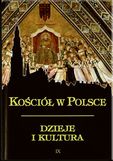ARCYBISKUPI GNIEŹNIEŃSCY A RUCH SOBOROWY
The Archbishops of Gniezno and the conciliar movement
Author(s): Łukasz KruckiSubject(s): Christian Theology and Religion, History of Church(es), Theology and Religion
Published by: Katolicki Uniwersytet Lubelski Jana Pawła II - Wydział Teologii
Keywords: Archbishops of Gniezno; councils; conciliarism; primacy; legates Natus; the dogma of papal infallibility; collegiality of the Church
Summary/Abstract: The Archbishops of Gniezno played an important role not only in the history of Catholicism on Polish soil. Through their activities they contributed also to the universal Church. This became visible during the five Ecu- menical Councils, in which the Ordinaries of Gniezno took part personally. Henry Kietlicz as the first of the Gniezno hierarchs participated in the Fourth Lateran Council, later did so Mikołaj Trąba (Council of Constance), Jan Łaski (the Fifth Lateran Council), Mieczyslaw Halka Ledóchowski (Vatican I) and Stefan Wyszyński (Vatican II). On the two councils – to Basel and Trento – the archbishops of Gniezno sent their delegates.By participating in the deliberations of the council the archbishops of Gniezno held a variety of functions, ranging from legacies, orators, representatives of diplomatic missions, to the great theologians or undisputed representatives of the nation, at a time when he was deprived of statehood. They always tried to play a more prominent role on these conciliar meetings. For their commitment they received honours and titles that permanently formed part of the history of the Church and the Polish state. Among the most important there were: primacy of Mikołaj Trąba, being a cardinal (although invalid) by Wincent Kota and the office of legate born (legatus Natus) awarded to Jan Łaski and his successors.
Journal: Kościół w Polsce. Dzieje i kultura
- Issue Year: 2016
- Issue No: 15
- Page Range: 97-118
- Page Count: 22
- Language: Polish

